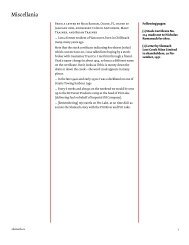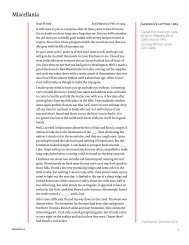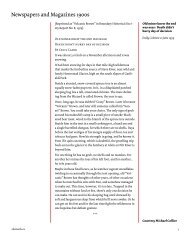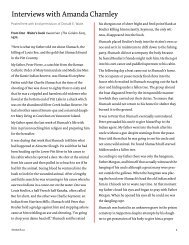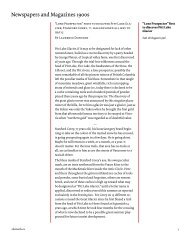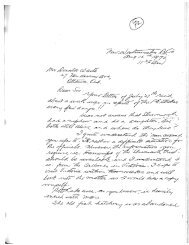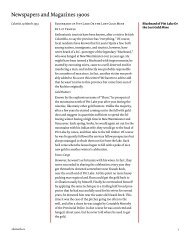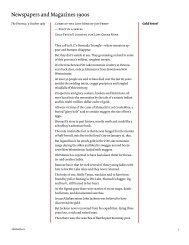14 Unusual and Uncanny - Slumach
14 Unusual and Uncanny - Slumach
14 Unusual and Uncanny - Slumach
- No tags were found...
You also want an ePaper? Increase the reach of your titles
YUMPU automatically turns print PDFs into web optimized ePapers that Google loves.
ing so deep they are hearing the screams from hell.WindOne prospector told me that while searching in theupper Pitt River - Iceworm Creek area both he <strong>and</strong>his partner became so unnerved by the frequent eeriesounds they heard coming from somewhere abovethem that they seriously considered terminated theirsearch.The prospector described the sounds as being a varietyof screams <strong>and</strong> moans comparable to the sound effectsof a horror movie. After considerable debate thepair, somewhat reluctantly, decided to find out whatwas causing the sounds.What they found on a rockface above them was an unusual rock formation fullsmall depressions, pockets <strong>and</strong> small holes of varioussize <strong>and</strong> depth. After careful observation they came tothe conclusion that the sounds were a natural phenomenon.When stronger gusts of wind blew acrossthe unusual rock formation a variety of unnervingsounds would emanate from the different pockets <strong>and</strong>holes. The variations in the ghostly chorus was entirelydependent upon the direction <strong>and</strong> velocity of the gustsof wind blowing across the natural oddity. These soundeffects can be loosely compared to the sounds made byblowing over the tops of bottles.The Lost WorldIn 1978, Warren Scott of Haney, B.C., informed thenews media of an exotic lost world he had discoveredin a small valley somewhere near the headwaters ofthe upper Pitt River. This secluded location apparentlyhad a tropical climate where extinct vegetation grewin abundance. Inhabiting the valley were 6 foot longmeat eating horned-lizards, huge white frogs <strong>and</strong> a 150year old man. Scotts’ original discovery of the ‘ primitivearea locked in time’ occurred in June 1973, near hisplacer gold mining operation. The gold mine is locatednear a small lake with an isl<strong>and</strong> in it at an elevation ofapproximately the 1800 meters.Scott apparently brought out a couple of small hornedlizards<strong>and</strong> gave one to the biology department atSimon Fraser University for study. The story continueson to say that a scientific expedition was dispatchedfrom the SFU to the location of the valley. The expeditionwas unsuccessful in locating the valley <strong>and</strong> returnedempty h<strong>and</strong>ed.I have never followed up on this story however it hasalways intrigued me. There are interesting similaritieswith other stories <strong>and</strong> I have also often wondered ifthere may be some type of unlikely common denominatorconnecting the old man from this story, the oldwoman the logger encountered, the old women Jacksonclaimed to have been helped by, <strong>and</strong> the missing nativetribe identified by Duff as the Squaalls.As strange as this may seem, I can honestly say that Ihave seen some type of horn or antler that did not comefrom any animal that I am aware of. If it was natural, itcame from some type of mutated life form that woulddefinitely interest the scientific community.When I worked at Pitt Lake one of the loggers had aunique object displayed on the wall above his bed in thebunkhouse. When I inquired about it he told me thathe had found the object in the Pine Cone Creek area,shortly before I began working there.The thing almost defies description. I can only say thatit looked like some kind of cross between an antler <strong>and</strong>a tusk. No one in the bunkhouse had ever seen anythinglike it before. Likewise, no one was able to identify whattype of animal it may have come from.The object was a very light s<strong>and</strong>y color, cylindrical inshape <strong>and</strong> straight. It was about 21/2 feet long <strong>and</strong> 4inches in diameter at the base. In addition to beingcylindrical it appeared to have grown in a spiral fashionalmost giving the appearance of tightly twisteddough. About half way up from the base it divided intotwo branches to form a very narrow ‘Y’ shape. The twobranches were straight <strong>and</strong> paralleled each other. Eachof these branches again divided into two short tines.The tines were about 2 inches in length <strong>and</strong> had verysharp points.I asked the logger it I could borrow his unidentified‘antler-tusk’ so that I could take it in for analysis <strong>and</strong>possible identification. He was just as excited <strong>and</strong> mystifiedabout it as I was <strong>and</strong> assured me that he wouldtake it to either the Fish <strong>and</strong> Wildlife department orUBC for identification as soon as his shift was over.The logger left for his days out only a day or two beforeme. I never did return to the camp because of my healthproblems. What became of the logger <strong>and</strong> this uniqueitem is unknown.The albino frogs in the lost valley story apparentlyhave an amphibian relative living in the main upperPitt River. An equipment operator running a front endloader at a gravel pit not far from the logging camp atAlvin dug a large white lizard out of the gravel bank.The lizard scrambled out of the bucket ran across theCopyright © 2002 Robert W. Nicholson



